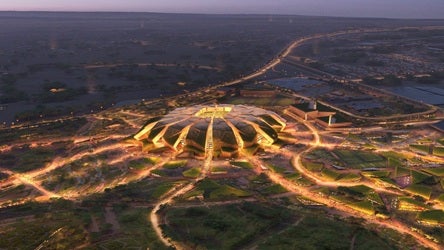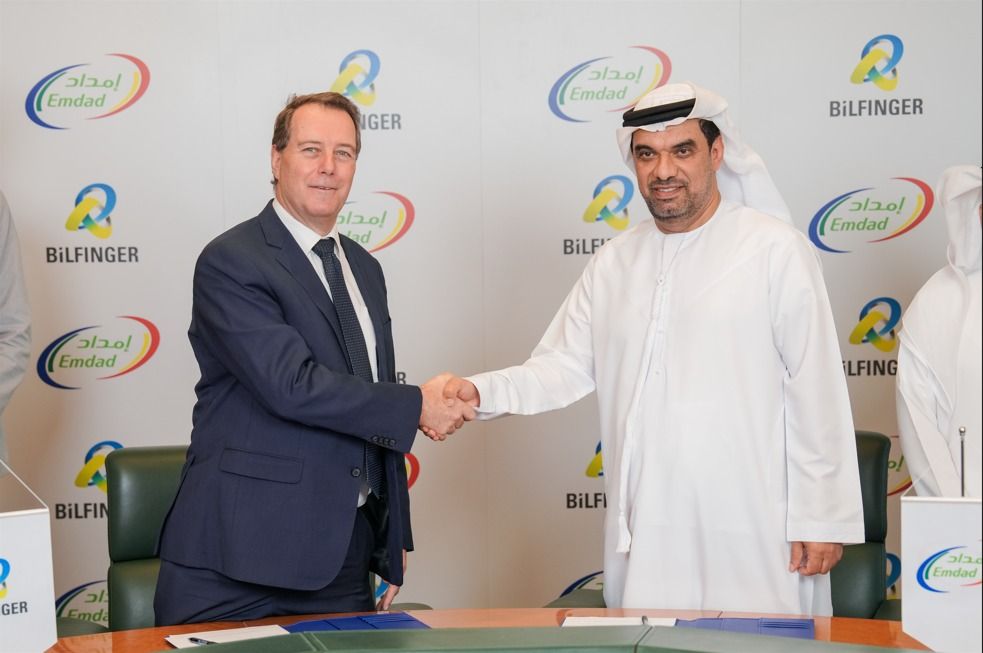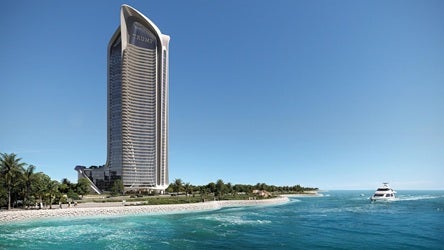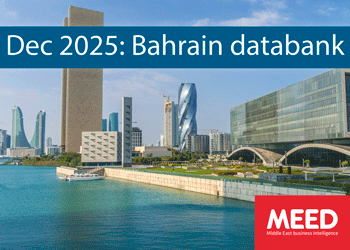Mena power rides high into 2024
29 December 2023

The Middle East and North Africa (Mena) region’s power generation and transmission sector awarded an estimated $25.3bn-worth of contracts between January and November 2023.
While this pales in comparison to the record high of $37.7bn awarded in 2015, it is up 38 per cent on the previous full year 2022, according to MEED Projects.
Year-on-year, the value of awarded power generation contracts increased by 40 per cent to reach $19bn, outperforming the transmission sub-sector growth by nine percentage points.
Saudi Arabia accounted for 60 per cent of the awarded power contracts in 2023. These include the contracts to develop four independent power projects (IPPs) that use combined-cycle gas turbines (CCGT), the first to be procured since the kingdom awarded the contract to develop the 1,500MW Al-Fadhili IPP to France’s Engie in 2016.
The Taiba 1 and 2 and Qassim 1 and 2 IPP projects each have a generation capacity of 1,800MW and require a combined investment of $7.8bn, of which roughly 80 per cent is accounted for by engineering, procurement and construction (EPC) costs.
The kingdom also awarded an EPC contract for the 1,200MW expansion of a power plant complex in Jubail during the year.
On the renewable energy front, the principal buyer, Saudi Power Procurement Company (SPPC), and the Public Investment Fund awarded some 6.7GW of solar photovoltaic (PV) IPP projects.
The uptick in awards marks a major improvement after a year of tepid renewables project activity in 2022, barring the solar and wind farm projects being developed as part of the large-scale green hydrogen and ammonia project in Neom.
The transmission and distribution sub-sector contributed to Saudi Arabia’s sterling market performance this year, delivering contracts worth over $3.5bn.
 The kingdom’s electricity grid is expected to continue to be upgraded to accommodate growing renewable energy capacity and the rise in electricity demand as Vision 2030-related projects enter the execution phase.
The kingdom’s electricity grid is expected to continue to be upgraded to accommodate growing renewable energy capacity and the rise in electricity demand as Vision 2030-related projects enter the execution phase.
The plan to accelerate electricity trade with its GCC neighbours and other countries in the region, such as Egypt and Iraq, is also anticipated to encourage future grid investments.
The award of the $2bn multi-utilities package for the Amaala development project also stood out, not least due to the inclusion of a 700 megawatt-hour battery energy storage system to enable the hotels within the development to be completely off-grid.
Unlike in the previous two years, Kuwait, the UAE and Oman also tendered or awarded substantial power generation contracts in 2023.
Nama Power & Water Procurement Company awarded the contracts to develop the second and third utility-scale solar PV schemes in the sultanate, Manah 1 and 2, each with a capacity of 500MW, in the first half of the year.
In September, Dubai Electricity & Water Authority awarded the contract to develop the sixth phase of the Mohammed bin Rashid solar complex.
Looking forward
The Mena power sector is expected to maintain its momentum into 2024, if the final quarter of 2023 is anything to go by.
Saudi Arabia is likely to continue dominating power project activities, with other states such as the UAE, Oman, Morocco, Egypt, Kuwait and Qatar offering significant opportunities for developers and EPC contractors.
Saudi Arabia’s SPPC has held a market-sounding event for the four solar IPPs under the fifth round of the kingdom’s National Renewable Energy Programme (NREP), while bid evaluation is still under way for the three wind IPPs under the NREP’s round four.
The tender documents are also being prepared for two CCGT projects in Riyadh, PP15 and Al-Khafji, with each expected to have a capacity of 3.6GW.
Qatar and Kuwait are advancing the procurement process for independent water and power producer (IWPP) projects that were held back over the past few years.
Abu Dhabi has initiated the procurement process for its fourth solar PV IPP and first twin battery energy storage facilities.
It will also almost certainly kick off the procurement process for one or two thermal power plants in the months ahead in anticipation of the need to replace expiring gas-fired capacity.
North Africa
The procurement of renewable energy plants, particularly in the North African states, led by Egypt and Morocco, is also expected to ramp up, in part due to their goals to develop green hydrogen hubs and export clean energy to Europe.
“Morocco is definitely going to be a major market from 2024 and onwards, with several IPPs in the planning and study stage,” says a senior partner with a transaction advisory firm.
Expectations also continue to thrive for many thermal projects planned in Libya and solar PV IPPs in Iraq, despite political uncertainties.
For Iraq in particular, the external pressure to rely less on Iranian electricity imports will provide impetus to its solar and CCGT capacity programmes.
The future trend for levelised costs of electricity is likely to remain mixed over the coming months
LCOE trend
The future trend for levelised costs of electricity (LCOEs) – or the pre-agreed, long-term tariffs an offtaker pays utility developers for their plants’ electricity output – is likely to remain mixed over the coming months, according to a region-based expert.
“The LCOEs for CCGTs are likely to remain stable next year, while solar LCOEs could slightly decline, compared with those seen in 2023,” the source tells MEED.
Supply chain constraints for gas turbines remain a concern for future CCGT power plants, given what is understood to be a long lead time for delivery and the production capacity constraints in the EU plants of the leading suppliers such as Germany’s Siemens Energy and the US’ GE.
While this opens opportunities for gas turbine manufacturers based in China, it is foreseeable that there remains a dominant preference for EU-made products across the Mena region, particularly in the GCC states.
The same expert argues, however, that the massive increase in gas turbine demand may be temporary, with demand likely to start petering off sometime after 2024, when clients and utility developers alike will have to consider the impact of these assets, whose concession agreements extend between 25 and 30 years, to their net-zero commitments.
As previously cited, Saudi Arabia will continue to dominate the region’s power sector project activities in the foreseeable future. Its ambition for renewable energy sources to account for half its capacity by 2030 and the Vision 2030-related plans to build off-grid developments such as Neom, the Red Sea and Amaala, as well as its multibillion-dollar industrialisation programme, will drive this.
According to MEED Projects data, Iran, Algeria, Kuwait, the UAE and Qatar are the other key markets for projects in the bidding stage. Morocco, Egypt, Kuwait and the UAE are the most promising markets for projects outside Saudi Arabia in the study, design or prequalification stage.
Overall, the net-zero commitments made by key states such as Saudi Arabia and the UAE, and plans to build green hydrogen valleys from Abu Dhabi to Morocco, in addition to an endemic rise in electricity demand as populations and economies grow, will likely keep the overall power sector buoyant over the coming years, barring any major events, like the Covid-19 pandemic in 2020 or the Russia-Ukraine war in 2022.
Exclusive from Meed
-
 Prequalification begins for Riyadh King Salman Stadium
Prequalification begins for Riyadh King Salman Stadium27 November 2025
-
 Morocco signs $861m deal for polysilicon plant
Morocco signs $861m deal for polysilicon plant27 November 2025
-
 Emarat awards contract for Dubai airport jet fuel pipeline
Emarat awards contract for Dubai airport jet fuel pipeline26 November 2025
-
 Arabian Construction Company wins Trump Tower Jeddah
Arabian Construction Company wins Trump Tower Jeddah26 November 2025
-
 Bahrain’s economy walks precarious path
Bahrain’s economy walks precarious path26 November 2025
All of this is only 1% of what MEED.com has to offer
Subscribe now and unlock all the 153,671 articles on MEED.com
- All the latest news, data, and market intelligence across MENA at your fingerprints
- First-hand updates and inside information on projects, clients and competitors that matter to you
- 20 years' archive of information, data, and news for you to access at your convenience
- Strategize to succeed and minimise risks with timely analysis of current and future market trends

Related Articles
-
 Prequalification begins for Riyadh King Salman Stadium
Prequalification begins for Riyadh King Salman Stadium27 November 2025
Register for MEED’s 14-day trial access
Saudi Arabia’s Sports Ministry has issued a notice inviting companies to prequalify for a contract to design and build the King Salman International Stadium in Riyadh.
The notice was issued on 26 November, with a prequalification deadline of 16 February.
The stadium will cover an area of about 660,000 square metres (sq m) and will have a seating capacity of 92,000.
The stadium will feature a 150-seat royal suite, 120 hospitality suites, 300 VIP seats and 2,200 dignitary seats.
The plan also includes several sports facilities covering more than 360,000 sq m, including two training fields and fan zones; a closed sports hall; an Olympic-sized swimming pool; an athletics track; and outdoor courts for volleyball, basketball and padel.
The new stadium will host the final of the 2034 Fifa World Cup and will serve as the Saudi national football team’s main headquarters.
US-based architectural firm Populous is the lead architect for the stadium.
Construction of the stadium is expected to be completed by 2029.
The stadium will be located next to King Abdulaziz Park.
Saudi Arabia stadium plans
In August last year, MEED reported that Saudi Arabia plans to build 11 new stadiums to host the Fifa World Cup in 2034.
Eight stadiums will be located in Riyadh, four in Jeddah and one each in Al-Khobar, Abha and Neom.
An additional 10 cities will host training bases. These are Al-Baha, Jazan, Taif, Medina, Alula, Umluj, Tabuk, Hail, Al-Ahsa and Buraidah.
There are expected to be 134 training sites across the kingdom, including 61 existing facilities and 73 new training venues.
The kingdom was officially selected to host the 2034 Fifa World Cup through an online convention of Fifa member associations at the Fifa Congress on 11 December 2024.
https://image.digitalinsightresearch.in/uploads/NewsArticle/15166460/main.jpg -
 Morocco signs $861m deal for polysilicon plant
Morocco signs $861m deal for polysilicon plant27 November 2025
Register for MEED’s 14-day trial access
Morocco has signed a MD8bn ($861m) investment agreement with GPM Holding to establish the country’s first polysilicon manufacturing plant in the southern province of Tan-Tan.
GPM Holding is a US-based company and a key partner in Green Power Morocco (GPM), which specialises in the installation and maintenance of photovoltaic solar panels.
GPM is a joint venture with UAE-based renewable energy company Amea Power.
The planned facility will be located in the El-Ouatia industrial zone, according to the North African country’s Ministry of Investment.
The facility will have an annual production capacity of 30,000 tonnes, with 85% earmarked for export.
The plant is expected to generate 1,500 direct and more than 2,000 indirect jobs and strengthen Morocco’s position in renewable energy supply chains, particularly in the manufacturing of solar panel components, according to the Ministry of Investment.
Last year, GPM completed a 34MW solar project in Hjar Nhal, south of Tangier, under a corporate power purchase agreement.
https://image.digitalinsightresearch.in/uploads/NewsArticle/15163133/main.jpg -
 Emarat awards contract for Dubai airport jet fuel pipeline
Emarat awards contract for Dubai airport jet fuel pipeline26 November 2025
Register for MEED’s 14-day trial access
Dubai’s Emirates General Petroleum Corporation (Emarat) has awarded a contract for engineering services for a project to build a new jet-fuel supply pipeline to Al-Maktoum International airport in the emirate.
The contract for end-to-end engineering design services has been won by Bilfinger Middle East, a subsidiary of Germany-headquartered Bilfinger Tebodin.
The expansion of Al-Maktoum International airport is estimated to be valued at $35bn. The government approved the updated designs and timelines for its largest construction project in April 2024.
In a statement, the authorities said the plan is for all operations from Dubai International airport to be transferred to Al-Maktoum International within 10 years.
The statement added that the project will create housing demand for 1 million people around the airport.
In September last year, MEED exclusively reported that a team comprising Austria’s Coop Himmelb(l)au and Lebanon’s Dar Al-Handasah had been confirmed as the lead masterplanning and design consultants on the expansion of Al-Maktoum airport.
Construction on the first phase has already begun. In May, MEED exclusively reported that DAEP had awarded a AED1bn ($272m) deal to UAE firm Binladin Contracting Group to construct the second runway at the airport.
The enabling works on the terminal are also ongoing and are being undertaken by Abu Dhabi-based Tristar E&C.
Construction works on the project’s first phase are expected to be completed by 2032.
ALSO READ: Dubai selects Al-Maktoum airport substructure contractor
https://image.digitalinsightresearch.in/uploads/NewsArticle/15160792/main0620.jpg -
 Arabian Construction Company wins Trump Tower Jeddah
Arabian Construction Company wins Trump Tower Jeddah26 November 2025
Register for MEED’s 14-day trial access
Abu Dhabi-based contractor Arabian Construction Company has won the main contract to build the Trump Tower Jeddah.
Saudi Arabia-headquartered real estate developer Dar Global is developing the project in collaboration with the US-based Trump Organisation.
The 47-floor tower is expected to be developed at an estimated cost of SR2bn ($532m).
The enabling works have been completed and were undertaken by the local Specialised Italian Foundation Company.
In August, MEED exclusively reported that Dar Global was preparing to award the main construction contract to build the Trump Tower development in Jeddah.
The project is the latest addition to Dar Global’s portfolio, following its announcement of two new projects in Riyadh with the Trump Organisation.
The announcement follows a partnership deal signed by Dar Global in September last year with Geneva-based jeweller Mouawad to develop a residential project in Riyadh.
The estimated SR880m ($234m) development will offer 200 residential villas north of Riyadh, close to the Expo 2030 site.
The development is expected to be completed by 2026.
According to an official statement, Dar Global has $7.5bn-worth of projects under development in six countries: the UAE, Oman, Qatar, the UK, Spain and Saudi Arabia.
UK analytics firm GlobalData expects the kingdom’s construction industry to record an annual average growth rate of 5.2% in 2025-28, supported by investments in transport, electricity, housing and tourism infrastructure projects and the Saudi gigaprojects programme.
The industry will also be supported by the government’s aim of increasing homeownership from 62% in 2020 to 70% by 2030, as part of Saudi Vision 2030.
https://image.digitalinsightresearch.in/uploads/NewsArticle/15159884/main.jpeg -
 Bahrain’s economy walks precarious path
Bahrain’s economy walks precarious path26 November 2025

MEED’s December 2025 report on Bahrain includes:
> COMMENT: Manama pursues reform amid strain
> GVT & ECONOMY: Bahrain’s cautious economic evolution
> BANKING: Mergers loom over Bahrain’s banking system
> OIL & GAS: Bahrain remains in pursuit of hydrocarbon resources
> POWER & WATER: Bahrain advances utility reform
> CONSTRUCTION: Bahrain construction faces major slowdown
> TRANSPORT: Air Asia aviation deal boosts connectivityTo see previous issues of MEED Business Review, please click herehttps://image.digitalinsightresearch.in/uploads/NewsArticle/15159666/main.gif

 Sustainability drives water investments
Sustainability drives water investments
